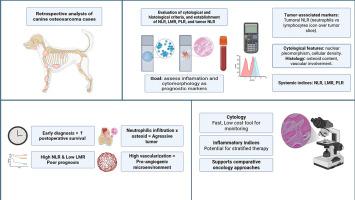Neutrophil-to-lymphocyte, monocyte-to-lymphocyte, and platelet-to-lymphocyte ratios as prognostic markers in canine osteosarcoma: Correlation with cytological and histopathological features
IF 1.8
3区 农林科学
Q1 VETERINARY SCIENCES
引用次数: 0
Abstract
Canine osteosarcoma is a highly aggressive neoplasm with a complex tumor microenvironment influenced by inflammatory and cytomorphological factors. This study aimed to evaluate the prognostic value of systemic and tumor-associated inflammatory indices, along with cytological and histopathological characteristics, in predicting clinical outcomes. A retrospective cohort of canine osteosarcoma cases was analyzed, assessing the neutrophil-to-lymphocyte ratio (NLR), lymphocyte-to-monocyte ratio (LMR), and platelet-to-lymphocyte ratio (PLR), in addition to cytopathological and histopathological features, as well as NLR values quantified in cytology. The results indicated that early clinical intervention significantly improved postoperative survival, reinforcing the importance of timely diagnosis. Both NLR and LMR showed significant correlations with tumor progression and prognosis, supporting their utility as continuous monitoring tools Tumor-associated NLR was linked to neutrophilic infiltration and osteoid content, suggesting involvement of the inflammatory response in tumor progression. Moreover, tumor-associated NLR inversely correlated with overall and postoperative survival times, supporting its association with tumor aggressiveness beyond cytological and histological features. Cytological and histopathological analyses highlighted nuclear pleomorphism and cellular density as potential malignancy indicators, supporting cytology as an accessible and cost-effective diagnostic tool. High vascular involvement was observed, reinforcing the hypothesis of a pro-angiogenic microenvironment contributing to tumor invasiveness. These findings emphasize the translational relevance of inflammatory indices and cytomorphological parameters in veterinary oncology, providing insights into tumor biology and potential therapeutic stratification strategies. Further studies are required to refine these biomarkers and integrate them into clinical protocols and comparative oncology research.

中性粒细胞与淋巴细胞、单核细胞与淋巴细胞、血小板与淋巴细胞比率作为犬骨肉瘤的预后指标:与细胞学和组织病理学特征的相关性
犬骨肉瘤是一种高度侵袭性的肿瘤,其肿瘤微环境复杂,受炎症和细胞形态学因素的影响。本研究旨在评估全身性和肿瘤相关炎症指标以及细胞学和组织病理学特征在预测临床结果方面的预后价值。对犬骨肉瘤病例进行回顾性队列分析,评估中性粒细胞与淋巴细胞比值(NLR)、淋巴细胞与单核细胞比值(LMR)和血小板与淋巴细胞比值(PLR),以及细胞病理学和组织病理学特征,以及细胞学量化的NLR值。结果表明,早期临床干预可显著提高术后生存率,加强及时诊断的重要性。NLR和LMR都显示出与肿瘤进展和预后的显著相关性,支持它们作为持续监测工具的效用。肿瘤相关NLR与中性粒细胞浸润和类骨含量有关,表明炎症反应参与肿瘤进展。此外,肿瘤相关NLR与总生存时间和术后生存时间呈负相关,支持其与肿瘤侵袭性的关联超越了细胞学和组织学特征。细胞学和组织病理学分析强调了核多形性和细胞密度是潜在的恶性肿瘤指标,支持细胞学作为一种可获得且具有成本效益的诊断工具。观察到高血管受累,加强了促血管生成微环境有助于肿瘤侵袭的假设。这些发现强调了兽医肿瘤学中炎症指数和细胞形态学参数的翻译相关性,为肿瘤生物学和潜在的治疗分层策略提供了见解。需要进一步的研究来完善这些生物标志物,并将其整合到临床方案和比较肿瘤学研究中。
本文章由计算机程序翻译,如有差异,请以英文原文为准。
求助全文
约1分钟内获得全文
求助全文
来源期刊

Research in veterinary science
农林科学-兽医学
CiteScore
4.40
自引率
4.20%
发文量
312
审稿时长
75 days
期刊介绍:
Research in Veterinary Science is an International multi-disciplinary journal publishing original articles, reviews and short communications of a high scientific and ethical standard in all aspects of veterinary and biomedical research.
The primary aim of the journal is to inform veterinary and biomedical scientists of significant advances in veterinary and related research through prompt publication and dissemination. Secondly, the journal aims to provide a general multi-disciplinary forum for discussion and debate of news and issues concerning veterinary science. Thirdly, to promote the dissemination of knowledge to a broader range of professions, globally.
High quality papers on all species of animals are considered, particularly those considered to be of high scientific importance and originality, and with interdisciplinary interest. The journal encourages papers providing results that have clear implications for understanding disease pathogenesis and for the development of control measures or treatments, as well as those dealing with a comparative biomedical approach, which represents a substantial improvement to animal and human health.
Studies without a robust scientific hypothesis or that are preliminary, or of weak originality, as well as negative results, are not appropriate for the journal. Furthermore, observational approaches, case studies or field reports lacking an advancement in general knowledge do not fall within the scope of the journal.
 求助内容:
求助内容: 应助结果提醒方式:
应助结果提醒方式:


